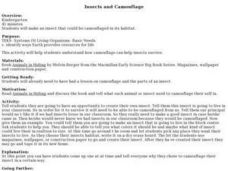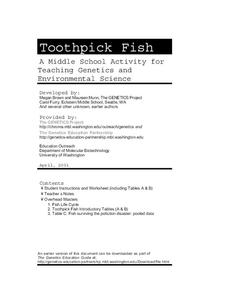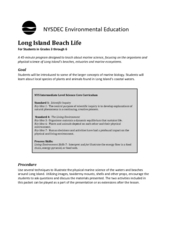Curated OER
Camouflage
Third graders collect insects and various bits of the insects' habitats in order to develop an understanding of how camouflage makes the insect fit to survive in its environment.
Curated OER
Camouflage
Students observe first hand what it is like to be the prey and what he or she must do to blend in and make themselves less noticeable. They participate in a variety of hands-on activities which help them explain how insects hide...
Curated OER
Where in the Wild?
Students investigate the purpose of animals' ability to camouflage. In this animal science lesson plan, students read the text Where in the Wild? and identify animals that are predators and prey. Students discuss how camouflage is...
Curated OER
U-G-L-Y? I've Got a Great Alibi
Students create a survey to explore people's perception of beauty. In this biology lesson, students explain how an animal's appearance helps it survive. They analyze survey results and present findings in class.
Curated OER
The Great Jellybean Hunt
Students explore natural selection and its influence on the populations to fine tune traits and characteristics. The acquisition of traits developed out of need is examined through a game played in class.
Curated OER
Insects and Camouflage
Students create an insect that can be camouflaged in its habitat. They study how camouflage can help insects survive.
University of Washington
Toothpick Fish
With colored toothpicks representing genes, youngsters practice passing them through generations of fish and learn about heredity. Consider this as an introductory activity since it does not represent recessive genes with lowercase...
Curated OER
Color Crazy
First graders create their own brightly colored animals. In this animal adaptations lesson plan, 1st graders create an animal that is brightly colored but can blend into it's environment.
Curated OER
Bioluminescence
Middle schoolers discover the concept of bioluminescence. They identify marine animals who have use this and why. They work together to test the function of bioluminescence as camouflage.
Curated OER
Comparing Sea Horses and Knights
Students investigate sea horses and knights. In this marine biology instructional activity, students read the book How to Hide an Octopus and discuss the purpose of camoflage. Students research knights and sea horses and record their...
Curated OER
The Great Jellybean Hunt
Young scholars model natural selection by acting as predators of jellybeans. In this evolution instructional activity, students use plastic utensils to pick up jellybeans. They use different colors of backgrounds to demonstrate the...
Curated OER
Color Your World with Changes --- the Camouflage Game
Seventh graders, after predicting dominant colors foud in their habitat or garden, visit heir area on a monthly basis. They search for colored toothpicks, then graph the results, determining the dominant color for the month.
Curated OER
Finding Math In The World Of Art
Students explore the use of Math in the world of Art. In this mathematics and visual art lesson, they design a picture using math digits that are camouflaged into a pictures. Additional cross curriculum activities are embedded in the plan.
Curated OER
Mariposas
Students examine how animals use camouflage for survival. In this investigative lesson students define vocabulary words and see how it is the environment that controls which adaptations will help in survival.
Curated OER
Long Island Beach Life
Have your class learn about marine life through this resource. This comprehensive lesson has learners discuss marine life, learn key vocabulary, discuss environmental concerns, and play games related to migration and predator/prey...
Curated OER
Pond Ecology
A lab activity is a great way to incite thoughtful questioning and scientific processes. Pupils will collect organisms with a Petri dish, make observations, sketch the organism, ask questions, then attempt to identify the specimen...
August House
Go to Sleep, Gecko!
A cute folktale from Bali tells the story of Gecko, Elephant, and Buffalo, and Gecko's struggle to sleep. After reading Go to Sleep, Gecko, learners focus on comprehension questions, singing and learning about geckos, building a house...
Curated OER
Animal Adaptations
Students use items from boxes to dress up classmates as animals adapted to a given environment.
Curated OER
Animals, Soil, Trees
Fourth graders describe the various kinds of soils and how plants and animals are affected by them. They describe the baic needs of plants, scoring at least a 3 or 4 on a 4-point rubic. Students are able to predict and/or infer what...
Curated OER
Going Buggy? Scavenger Hunt
For this insects worksheet, students utilize the Internet to access a specific website to locate the answers to five short answer questions involving insects.
Curated OER
The Froggy Page
Learners investigate the cycle of life by observing tadpoles. In this biology lesson, students utilize the Internet to read stories, observe pictures, and listen to sounds of frogs. Learners create a poster board collage using frog...
Curated OER
Where Are The Dinosaurs?
Students study the existence of dinosaurs as a precursor to learning about extinction. In this dinosaurs activity, students watch dinosaur video at assigned web sites. They discuss what they observed in the videos including how the...
Curated OER
Discovering Owls
Students are introduced to different types of owls and owl pellets. They list several adaptations that benefit the owls. Students identify the various species of owl that live in Wisconsin. Students discuss owl pellets and identify the...
Curated OER
Using Description to Write in Science
Fifth graders use science process and thinking skills. They communicate effectively using science language and reasoning.

























